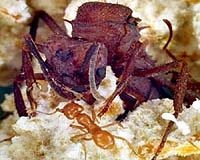| . |  |
. |
Miami (AFP) July 2, 2010 In an ambitious and unprecedented plan to save wildlife, volunteers in coming weeks will move tens of thousands of turtle eggs from oil-soaked Gulf of Mexico beaches to safety on Florida's Atlantic coast. The eggs, which could number some 70,000, will be carefully hand-picked, placed in special containers, and in driven in temperature-controlled FedEx trucks starting in mid-July, according to the company and rescue officials. "There are about 700 nests in Florida and the affected area, and the number of eggs in each it can be anywhere to a 100 to a 128 per nest," said Patricia Behnke, with the Florida Fish and Wildlife Conservation Commission. The eggs "will be incubated in a storage unit, a private facility close to Cape Canaveral," on Florida's Atlantic coast. she said. After a 50-60 day incubation period the hatchlings "will be taken out to the beach at night and released into the sea, probably in an area in mid-eastern Florida coast," Behnke said. The whole process it could last up to four month, she said. "A plan like this is absolutely unprecedented and it would not be the choice of our scientists," she said. However the hatchlings are at great risk staying on the oil-soaked Gulf of Mexico beaches and within reach of ocean water polluted by oil and chemical dispersants, she said. Staff with the US Fish and Wildlife Service (USFWS) and the National Oceanic and Atmospheric Administration (NOAA) are also participating in the egg rescue. NOAA warned of the risks of damaging the eggs, but said in a statement that taking no action "would likely result in the loss of all of this year's northern Gulf of Mexico hatchlings." Florida beaches have the highest concentration of turtle nests in the United States, many of them located in the oil-stricken northwestern panhandle area. This egg moving plan "applies to nests deposited on Florida panhandle and Alabama beaches during the 2010 nesting season only, as it is this year's cohort in the Northern Gulf area which is at the highest risk for encountering oil after entering the ocean," said Barbara Schroeder, NOAA Fisheries national sea turtle coordinator. Animal welfare groups on Wednesday sued BP for burning endangered sea turtles and asked a federal court to stop "controlled burns" in the Gulf. "It is horrifying that these innocent creatures whose habitat has already been devastated by the oil spill are now being burned alive," Animal Welfare Institute (AWI) President Cathy Liss told the court in Louisiana. An estimated 430 sea turtles from endangered species have died so far in the oil spill, according to animal welfare groups. The lawsuit filed by AWI, Center for Biological Diversity, Turtle Island Restoration Network and Animal Legal Defense Fund said BP was violating the Endangered Species Act and other laws with their "controlled burns" in the Gulf of Mexico. They asked the court for a temporary restraining order to stop all burning activities "until... mechanisms are implemented that will prevent any additional sea turtles from being burned alive." "Endangered sea turtles, including the Kemp's Ridley, one of the rarest sea turtles on Earth, are caught in the gathered oil and unable to escape when the oil is set ablaze," the animal welfare groups said.
Share This Article With Planet Earth
Related Links Darwin Today At TerraDaily.com
 The Ant Queen's Chemical Crown
The Ant Queen's Chemical CrownCopenhagen, Denmark (SPX) Jul 02, 2010 The defining feature of social insects is that societies contain queens, which specialise in laying eggs, as well as workers, which are mostly infertile but take care of the offspring and the nest. However, when the queen dies or is re-moved, workers begin laying eggs of their own. Previous observations have suggested that queens possess a specific pheromone which keeps the workers infer-t ... read more |
|
| The content herein, unless otherwise known to be public domain, are Copyright 1995-2010 - SpaceDaily. AFP and UPI Wire Stories are copyright Agence France-Presse and United Press International. ESA Portal Reports are copyright European Space Agency. All NASA sourced material is public domain. Additional copyrights may apply in whole or part to other bona fide parties. Advertising does not imply endorsement,agreement or approval of any opinions, statements or information provided by SpaceDaily on any Web page published or hosted by SpaceDaily. Privacy Statement |